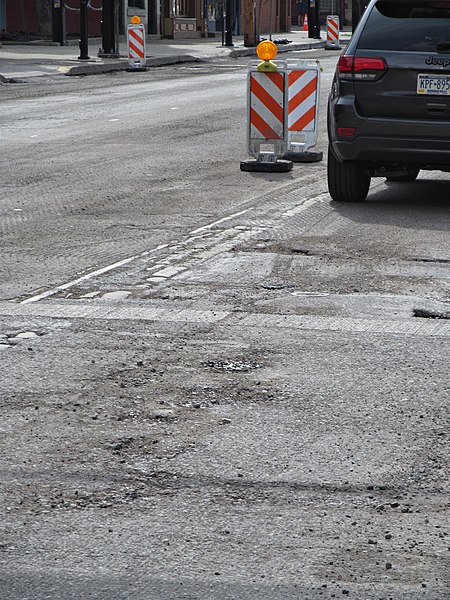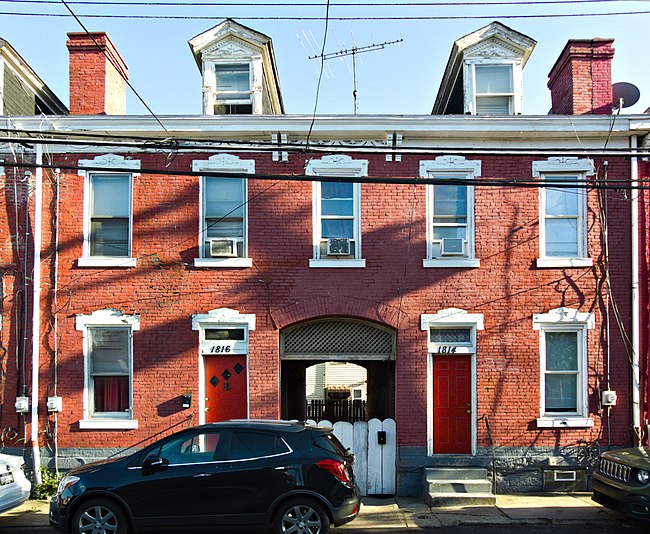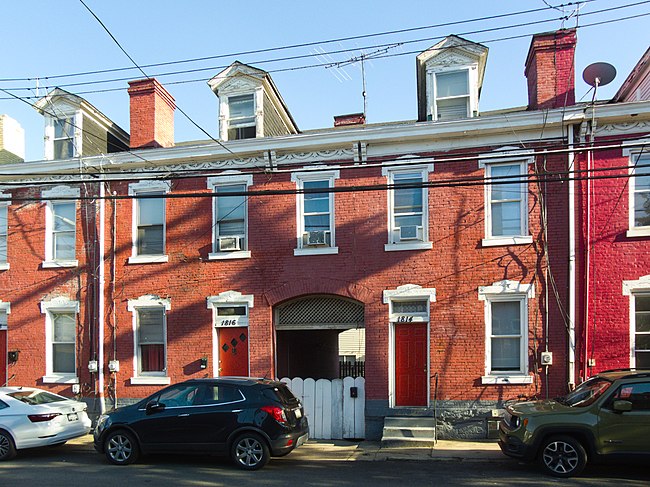
Scratch any major street and you’ll find streetcar tracks, as we see here on Carson Street on the South Side, currently under construction.

In Pittsburgh, a “rowhouse” is generally any house that shares a wall with its neighbors. But there are rowhouses in a stricter sense: rows of houses built all at once, as more or less one building divided into individual residences. One such row is in the 1800 block of Carey Way, a row of modest Italianate alley houses all put up at once. If he had to guess, old Pa Pitt would date it to the 1870s. One of its remarkable features is its breezeway. Most breezeways in Pittsburgh are narrow passages between houses, but this row has one breezeway in the middle big enough to drive a wagon through. That is probably the point: it leads to a courtyard from which deliveries of coal and other staples could be made to the backs of all the houses. Under separate ownership, the houses have ceased to be entirely identical, but their common origin is still apparent.




Here are two very similar churches in the same block of Bingham Street, both from the 1850s, and both built with the sanctuary on the upper floor. In the middle 1800s, this was a common adaptation for churches in crowded neighborhoods of Pittsburgh and adjacent boroughs (Birmingham was still independent until 1872). Built on tiny lots, they needed space for Sunday-school rooms and social halls, but the sanctuary obviously needed a high ceiling or it would look and feel absurd. Thus the ground floor was left for the smaller rooms.
The church above was the Bingham United Methodist Church (built 1859), now the City Theatre. It is a generic church-shaped church with vaguely classical details, including rounded arches in the windows. The same shape could be given details in any style; the church below is the First Associated Reformed Presbyterian Church of Birmingham (built 1854), with a very similar outline, but Gothic pointed arches in the windows. The windows along the sides are simple rectangles, and old Pa Pitt suspects that the 14th Street end was Gothicized at some time in the later 1800s.


The name “First Associated Reformed Presbyterian Church of Birmingham” is too long to fit on a date stone.

Boston ivy is eagerly devouring the entrance, so it is hard to see that this arch is also pointed.
When this article appeared, Joseph Moore commented:
Are those really the main doors for the Presbyterian Church? Very plain – look more like a loading doc than the entrance to a church, even a Calvinist one. The United Methodist Church has the architectural articulation one would expect for the main doors for a church.
We replied:
The main entrance might have been on the long side on Bingham Street, where the garage door is now. On the other hand, the Gothic arch with columns on the end (and the very interesting woodwork on the doors) does suggest that someone intended it as a main entrance. On the third hand, one would expect more natural light in a main entrance, which would probably have led into a foyer with a stairway (or a pair of stairways, as in the South Side Presbyterian Church). And on the fourth hand, it is possible that windows flanking the entrance have been bricked up. Old Pa Pitt has not been able to persuade himself that the brickwork is all original, and he has not been able to persuade himself that it is not. And on the fifth hand (we might as well be an octopus by now), Father Pitt has not been inside this building; it is possible that the whole front is a stairwell, in which case the large Gothic windows would provide ample light.
This was one of the small number of articles that did not survive the transition between servers, so it had to be reconstructed and the comments copied by brute force.

Many fine rowhouses like this one adorn the South Side, but once in a while we find one where the owners who restored the house have looked up its history and encapsulated it on a plaque. This is one of them, so we know that the house was built in 1891 for Charlotte and Wilhelm Geauf, and that the building cost $3,000 on a lot that cost $2,000. Note the fine parlor window—always the best opportunity for showing off in a rowhouse like this—and the richly textured brick cornice.

Sarah Street was the prime residential street of East Birmingham (the part of the South Side between 17th and 26th Streets), and it retains some of Pittsburgh’s most distinguished rowhouses. The one above is a splendidly eclectic mix—a bit of Italianate, a bit of Gothic, a bit of Second Empire. Note how much effort has gone into making interesting patterns in the bricks.

Here is another house in a similarly eclectic style. The parlor window is treated almost identically, but the upper floors vary the theme considerably.

This is not strictly a rowhouse, since it is detached from its neighbors by a narrow alley on each side; but since it is connected to those neighbors by a pair of gates, it is as near a rowhouse as makes no difference. This is a fine example of the Italianate style in a city house, and the owners have had some fun picking out the ornamental details with an unusual but effective paint scheme.

This is now the Carson City Saloon, because everything on the South Side eventually becomes a bar. But the whole building shouts “bank.” It’s built from classical elements like a Venetian Renaissance palace.

The date stone tells us that the bank was put up in 1896, with palm fronds signifying victory, and anti-pigeon spikes signifying “We hate pigeons.”

This ornamental ironwork is meant to evoke the balconies on a Renaissance palace, without actually being useful as a balcony.
